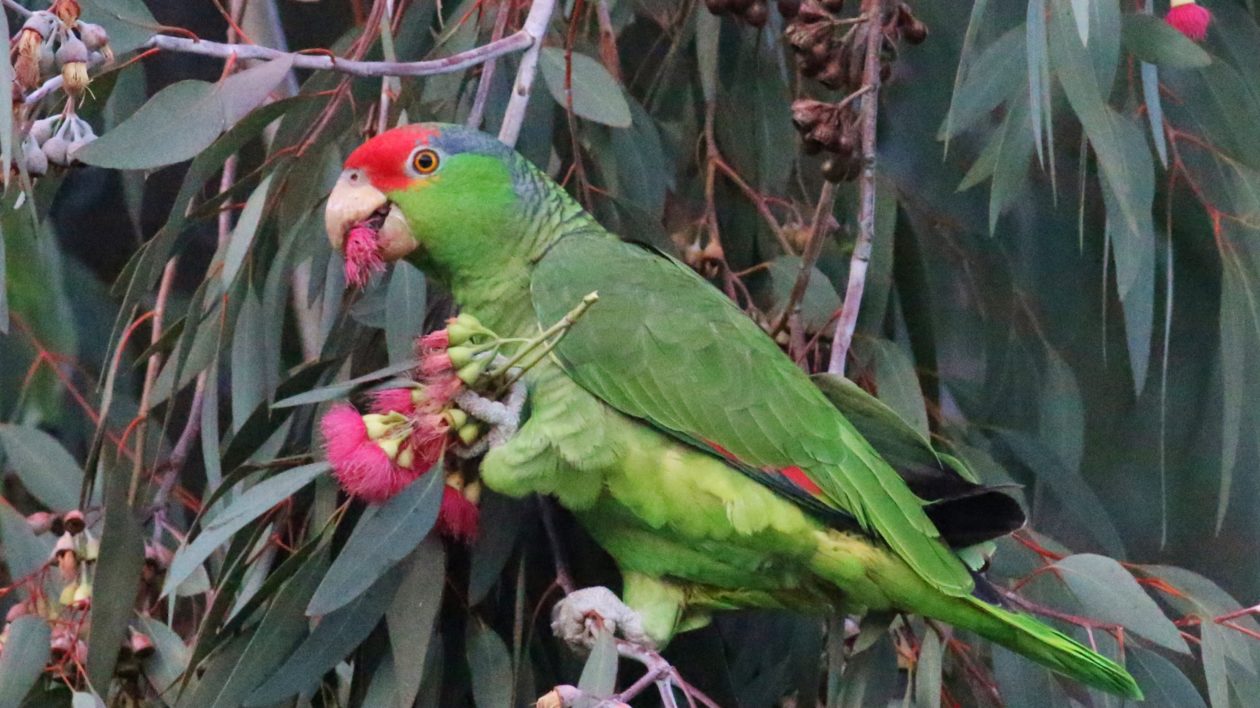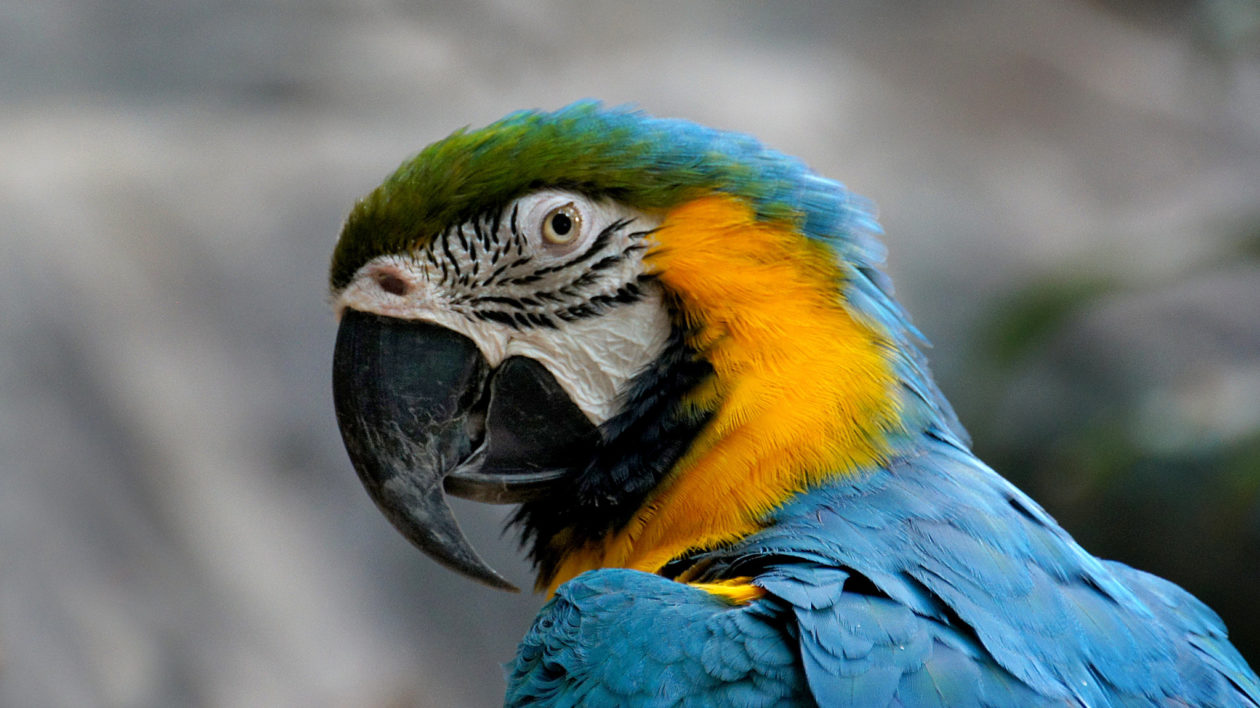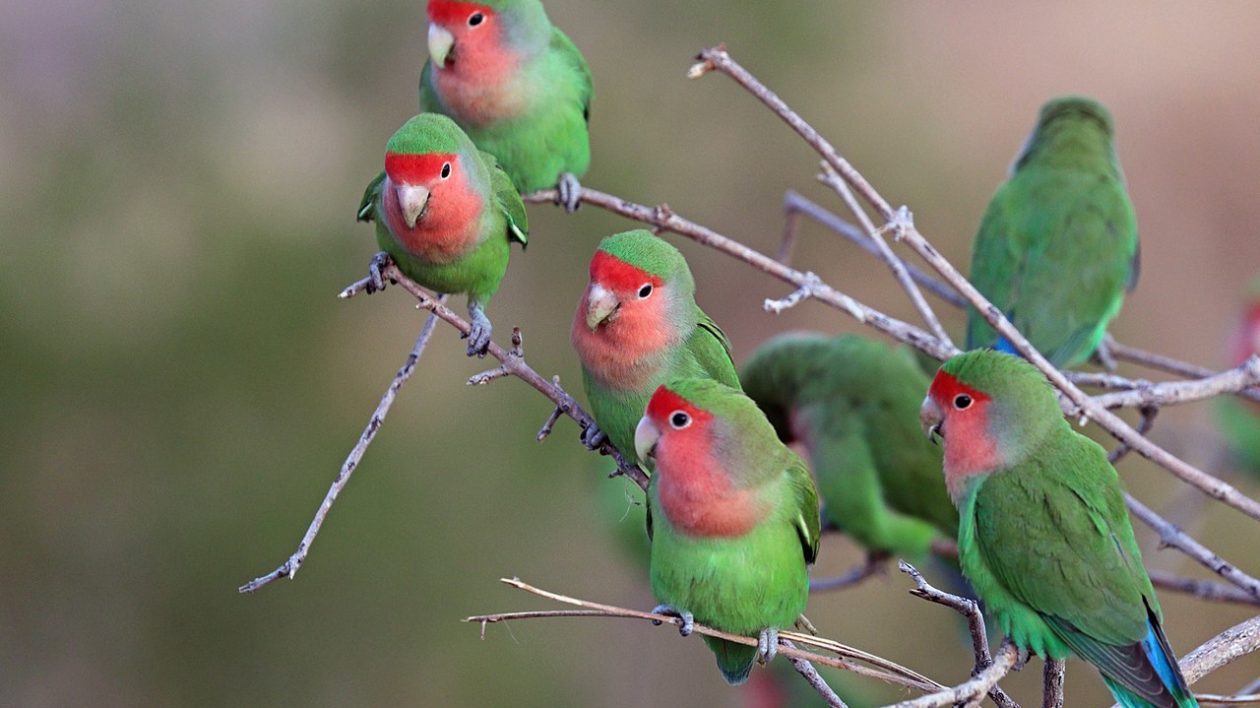“Wait, was that a parrot?”
I’m looking out of my hotel room window in downtown Los Angeles, and I swear I just saw a parrot in the palm trees across the highway. Either that, or the 17+ hours of jetlag are causing me to hallucinate.
But the next day, now well rested, I see them again — a flash of green and gold in the hazy sun. Later, both my colleague and my Sibley bird guide confirmed that I had indeed seen a Yellow-chevroned Parakeet, one of several that have established breeding colonies amid the skyscrapers and urban sprawl of LA.
As some birders and sharp-eyed observers may already know, the US is home to dozens of feral parrot species. Using data from eBird and the Christmas Bird Count, scientists recently tallied 56 different parrot species sighted in 43 states, 25 of which are now breeding in the wild across 23 different states.
So how did these wayward parrots get here?
Native Parrots, Lost & Found
The United States once had two endemic parrot species, the Carolina Parakeet and the Thick-billed Parrot. Once found in the east and midwest, Carolina Parakeets went extinct in 1918, likely due to widespread deforestation and direct hunting. (The last captive bird, named Incas, lived and died in the same cage as Martha, the famed last Passenger Pigeon.)
The Thick-billed Parrot, though not extinct, is now only found in Mexico. The birds once ranged into Arizona and New Mexico, but a combination of heavy shooting, logging, and development drove the species back across the Mexican border. The bird was last seen in the US in the Chiricahua Mountains in the late 1930s, and reintroduction attempts in the 1980s and 1990s were unsuccessful.
So went the country’s two native parrot species — or so we thought. The Green Parakeet and the Red-crowned Parrot could also be native to the US, as their range occasionally extends into southern Texas. (Whether or not they are native, and if they warrant protection as endangered species, is controversial.)Either way, both birds are also established ferals elsewhere in the country.
Today, the vast majority of parrots sighted in the US are non-natives. Birds are either escaped pets, creating one-off sightings, or they are the descendants of pets that have now established permanent breeding colonies.
Take the Monk Parakeet: a squat, lime green bird native to South America. In the 1950s and 60s, tens of thousands of Monk Parakeets were imported to the US as pets. Inevitably, some escaped or were set free when their owners tired of a loud, messy, demanding, long-lived pet. Now 70 years later, the Monk Parakeet is the most abundant feral parrot in the country.

Tips for Identifying Feral Parrots
First, the good news: It’s usually pretty easy to tell when you’ve spotted a parrot, because there aren’t any common native birds to confuse them with. And now the bad news: Sorting out exactly which parrot species you’ve seen isn’t always easy. Here are our tips for making your ID:
Get a good bird guide: We recommend the Sibley (second edition) for it’s superb illustrations of most of the common feral parrot species.
Learn what to pay attention to: Most parrot sightings are little more than a flash of quick-beating green wings, maybe a splash of red, and some squawking. You know you’ve seen a parrot, but that’s about it. Noting a few quick details during flyovers can help you narrow down to a species.
First, pay attention to color. Most of the feral species in the US are green. But many also have blue, yellow, or red coloration on their bodies. Details like a red forehead, blue under the wings, or yellow back will be critical to narrowing down your options.
Second, pay attention to shape. How long are the wings? Short and wide or long and tapered? And what is the ratio of the bird’s tail length to body? Does it have a short tail, or an elongated shape with long tail feathers?
And lastly, if you can, try to note the size (chunky or dainty) and color (light or dark) of the bill.
Remember that parrots are hard: Don’t get discouraged. Parrot flyovers can reduce even experienced birders (and yours truly) to swear-filled rants of frustration.

The Top Three Feral Parrots
Just three species — Monk Parakeet, Red-Crowned Parrot, and Nanday Parakeet — make up 61 percent of all sightings reported on eBird and CBC over the last 15 years. If you study these three species using our guide below, you’ll be in a good position to identify the most likely candidates, or rule them out if you find something more unusual.
Monk Parakeet (Myiopsitta monachus)
I’d wager that this chunky green bird is the most commonly sighted feral parrot in the US, because they’ve established conspicuous breeding populations in at least 21 states, including colonies in several major US cities. Note the green body and tail, blue wing-tips, white chest and chin, and orange bill.
Another hint: Look for a nest. Most parrots are cavity nesters, laying eggs in hollow tree limbs and trunks. But the Monk Parakeet is the exception. This species builds an elaborate, tangled stick nest accessed by a small tunnel. Many pairs share the same nest, which can look like a mini beaver dam in the sky. So if you see a small, green bird popping and out of a stick nest, then you can be reasonably sure it’s a Monk Parakeet.

Red-crowned Parrot (Amazona viridigenalis)
Also known as the Red-crowned Amazon. Whether or not this species counts as “native” depends on who you talk to. Some say that the populations in the Rio Grande Valley are the product of both escapee pets and wild birds, others disagree. Complicating matters is the question of whether or not the bird deserves protection as an endangered species.
Red-crowned Parrots are found elsewhere in the US, with breeding populations descended from escapee pets in greater Texas, California, and Florida. Note the green body, dark wingtips, light beak, dusky blue-grey nape, and bright red forehead. (Other species also have red-and-green faces, so look closely.)
This species is now endangered in its native range, thanks to habitat destruction for agricultural and ranching uses, as well as illegal trapping for the pet trade. Scientists thnk it’s possible that there are now more feral Red-crowned Parrots in the US than there are in their original habitats in Mexico.

Flickr
Nanday Parakeet (Aratinga nenday)
Also known as the Black-hooded Parakeet, Nandays are native to the wetlands of the Pantanal region in central South America. Look for a yellow-green body and long tail, blue-black wings, and a distinctive dark head and bill. If you look closely, they also have a little bracelet of red feathers the bottom of each leg.
In the US, Nandays are found throughout central and southern Florida, and in California’s greater Los Angeles and Orange County regions. The species is occasionally sighted in Arizona and Texas.

Feral Parrot Hotspots
Another great way to narrow down a mystery parrot sighting is by location. Together, three states — Florida, Texas, and California — support populations of all 25 species of breeding parrots in the USA. And several other major cities have well-established populations of one or more species.
Here are some common places to spot established breeding colonies of feral parrots. (And if you don’t live or bird in one of these places, we recommend using eBird to see which feral parrots are reported in your area.)
Oh, Florida! A Feral Parrot Paradise
Florida is well known as a veritable wonderland of invasive and non-native species, from the pythons lurking in the Everglades to iguanas stalking suburban streets. The same holds true for parrots.
Most established populations are found in the southern end of the peninsula, and birders have sighted more than 35 species in Miami-Dade county alone. Miami is particularly famous for its resident flock of more than 20 Blue-and-gold Macaws, which have lived there for more than 30 years. Unfortunately, this population is declining as the birds, which lack any legal protection, are being legally poached for the pet trade.

California Parrot Dreaming:
San Francisco’s Red-masked Parakeets were once the most famous parrots in the country. In 2003, an award-winning documentary — “The Wild Parrots of Telegraph Hill” — followed a homeless musician and his relationship with the neighborhood flock of feral parrots. More than 15 years later the birds are still there, but many in the 300-strong flock are being sickened or by killed rat poison set out to control the city’s rodents.
Feral parrots are common in California’s other major cities. Los Angeles, San Francisco, and San Diego all have populations of Red-masked Parakeets, Yellow-chevroned Parakeets, Blue-crowned Parakeets, Rose-ringed Parakeets, among others.

Coast-to-Coast Urban Parroting
Outside of Florida and California, many cities have well-documented populations of feral parrots. You can find Monk Parakeet colonies in Brooklyn (check out Greenwood Cemetery), Boston, Houston, Austin, Dallas, Chicago, and New Orleans, among others. In Phoenix, look for Rosy-faced Lovebirds. And amidst a long list of non-native birds in Hawaii, you can find Red-crowned Parrots on Oahu and Mitred Parakeets in Maui.




What a fascinating story! Thank you for sharing your experience of spotting the Yellow-chevroned Parakeet in downtown Los Angeles. It’s incredible how resilient and adaptable these parrots are, thriving in urban landscapes despite being far from their native habitats. Your storytelling beautifully captures the wonder of unexpected wildlife encounters and highlights the rich history of parrots in the U.S. I appreciate the insight into both native and introduced parrot species—especially the reminder of the Carolina Parakeet and Thick-billed Parrot’s history. This was a truly engaging and informative read!
I went out on the patio to enjoy my morning coffee, when I see a green bird with a brilliant red head trying to swoop down on some food I had put out for the pigeons. It was not successful, BUT it flew on the wall and my eyes followed it and there were two more just like the first one that I spied. they had a bit of a chit chat and flew away into a large tree across the way. that is something I have not seen before, ever.